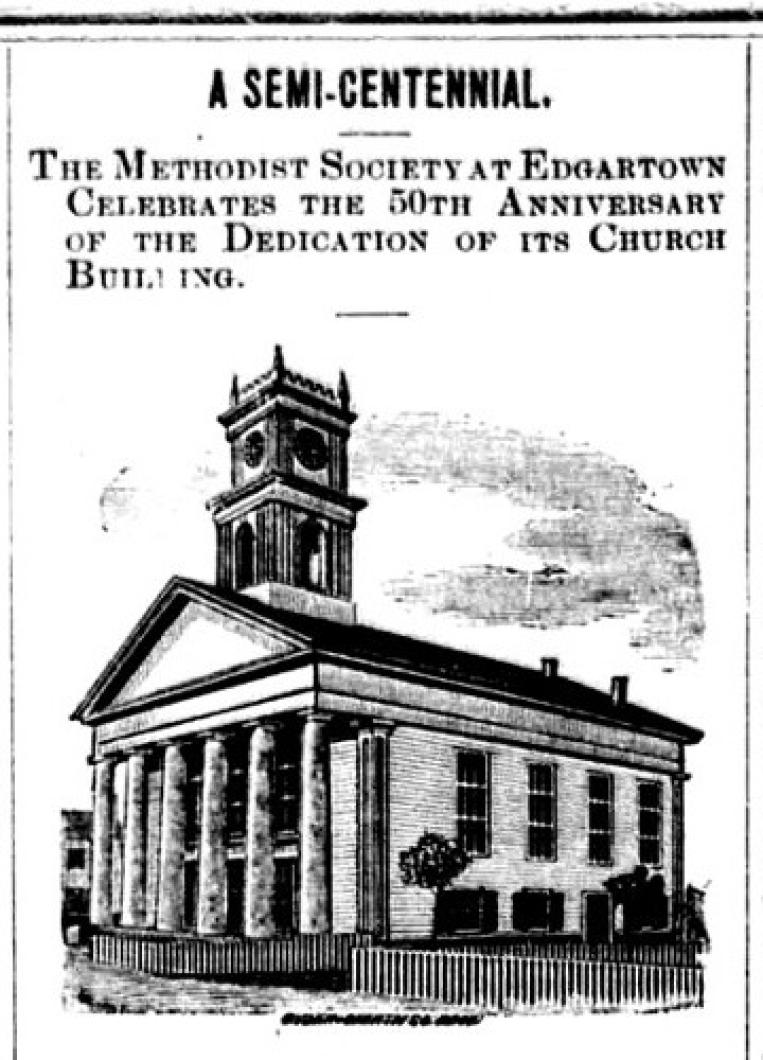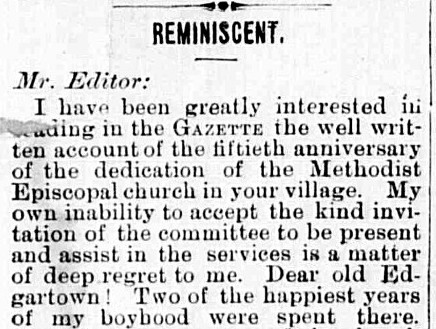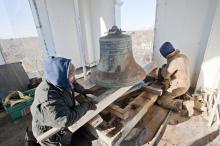Three days of perfect October sunshine marked the observance of the fiftieth birthday of the noble church building which for half a century has been the pride of Edgartonians, regardless of denomination.
Located upon the main street, directly on the line of travel from the railroad station to the various hotels, for years it has attracted the admiration and wonder of the passing stranger - admiration for its beauty, yet simplicity, of architecture, and wonder at finding a church edifice of such grand proportions in a small seaport town.
And thousands of times, probably, has the stranger been told the old familiar story of how Edgartown in the 40’s, when the church was built, was entering upon an era of great prosperity - her palmy days - her ships and masters sailing the seas of every ocean on the globe, and bringing to the old port cargoes of oil, yielding fortunes to her citizens. Her wharves were noisy with the quick, sharp strikes of cooper and caulker, and the “heave away” of the stevedore was heard on every hand. Her streets resounded with the rumbling of oil laden trucks, and her walks were filled with jolly American seamen just home from the Pacific with a full ship, or mayhap about to sail anew in quest of oil and fortune.
In the days when this church was building the future of the old town was bright with promise, and Edgartown did indeed mount upon a high wave of prosperity which carried her on its crest until the early 60’s and then, slowly subsiding, left her rich, respectable, and smilingly content.
And we are thankful that the fathers built with such generous provision for the future; that the house has stood for fifty years a noble monument to the sturdy faith of its builders - their faith in God, and faith in their town’s material prosperity.
And so for more than half a century the fierce storms of winter and the soft breezes of summer have played around the old church tower, and the bell in its belfry has called to worship two generations of members, the first of whom are now nearly all sleeping in the silent city of the dead. The bell has made merry music at the wedding of many of Edgartown’s loveliest maidens, and it has tolled to the grave scores of her best loved citizens.
The erection of the present church building was completed in the autumn of 1843. Through the kindness of Mrs. Fannie A. Deane, we are privileged to copy the following concerning its erection and dedication from “History of Methodism on Martha’s Vineyard,” as prepared by the late Rev. Hebron Vincent. Referring to the building (at the present time used as a Town Hall), Mr. Vincent says:
“Although the House of Worship occupied by the church and congregation in Edgartown was an excellent building, and of medium size for the population, yet such had been the success attending Christian effort that the place had become too small for the people. The house was fifty feet by forty, twenty-two feet post, without side galleries. It had about fifty pews. Well packed, the audience room would seat about 300 persons. At this time every pew was occupied, and some twenty or more had been wanted by persons able to purchase. The lot on which the house stood had been parted with by its former owner to his own inconvenience, and was limited to the size of the building, or nearly so, and therefore the latter could not be enlarged. What, then, should be done?
“The whaling enterprise, which was then the principle business of the town, was prospering, the population was increasing, lumber was comparatively cheap, and there was a large number of mechanics, especially of carpenters, in the church and society. The several places of worship previously occupied had successively given place to more commodious ones, as God had blessed his people and increased their numbers. Thus all things seemed to point to the erection of a house for the worship of the Lord which would in all probability be sufficiently spacious as long as it should remain otherwise suitable for occupancy. Accordingly, after mature deliberation, this course was determined upon. A suitable lot of land was purchased, the plan of the contemplated church edifice matured, the requisite material obtained - that for the frame being very massive, and other preparations were made during the present year.
“During the two succeeding years, 1842 and 1843, the Rev. Charles S. Macreading, who has gone to his reward on high, was the stationed preacher, Spiritual prosperity still attended this branch of Zion, and some were added to the Lord and to the church.
“The new spacious church edifice was completed in the autumn of 1843. It had an audience room containing on hundred and four pews, and a gallery planned for the reception of an organ. It had a vestibule of convenient size, and a basement, for vestries, entirely above ground. A large and rich toned bell was placed in the noble tower. Altogether this church, although not so large as many in more populous places, was a credit to, as well as a commodious provision for the wants of the people erecting it, and an ornament to the town. The plan of the house was drawn by Mr. Frederick Baylies, for many years a member of the church, and the work of erection was superintended by Mr. Ellis Lewis, one of the society. The enterprise was conducted by a building committee, consisting of Thomas M. Coffin, Frederick Baylies, Jeremiah Pease, Josiah Gorham, John G. Morse, Charles Worth and Hiram Jernegan. When completed it was formally transferred to a board of nine trustees, by a deed of settlement in accordance with the Discipline and usages of the M. E. Church, bearing date of November 10, 1843.
“The dedication took place on the tenth day of October, 1843. There was a great gathering together of the people from this and other parts of the Island. The sittings were intensely crowded, and aisles and recesses thronged. The sermon was by the Rev. (now Dr.) Minor Raymond, then Principal of the Wilbraham Academy. The text was, Acts xxviii: 22; ‘But we desire to hear of thee what thou thinkest: for as concerning this sect, we know that everywhere it is spoken against.’ The discourse was a rich production - an able discussion of Gospel truth, interspersed with lofty passages of eloquence - specimens of the preacher’s characteristic style. The services were all of great interest. The Methodist E. Church in Edgartown thus entered upon a new epoch in its history.
“The former house, which, with its ever memorable vestry had been glorious on account of the Divine presence and favor there manifested in the comforting of God’s people and the multiplying of converts, was subsequently sold to the town to be used for the purposes of a Town Hall.”
Beginning with Rev. Mr. Macreading in the 1843 the long roll of pastors is as follows:
Rev. Charles S. Macreading, 1842-3
“ William T. Harlow, 1844-5
“ Cyrus C. Munger, 1846-7
“ Thomas Ely, 1848
“ Frederick Upham, 1849
“ Charles H. Titus, 1850-51
“ John B. Gould, 1852-3
“ William Kellen, 1854
“ Sanford Benton, 1855-6
“ William H. Stetson, 1857-8
“ Lucius D. Davis, 1859-60
“ Charles Nason, 1861
“ Frederick A. Crafts, 1862-3
“ Seth Reed, 1864-*5
“ A. W. Paige, *1865-6
“ George W. Bridge, *1867
“ Andrew J. Church, *1867-68-69
Dr. Daniel A. Whedon, 1870-71-72
Rev. Elisha M. Dunham, 1873-74-75
“ Samuel M. Beale, 1876-77-78
Dr. John D. King, 1879-80-81
Rev. John O. Thompson, 1882
“ James H. Humphrey, 1883-84-85
“ Silas Sprowls, 1886
Dr. John D. King, 1887-88-89-90
Rev. Herman C. Scripps, 1891-9-93
*Part of that year.
As stated above the present church building was dedicated Oct. 10, 1843. After fifty years of continuous use as a place of worship, the present Board of Stewards of the church decided to observe the semi-centennial of the dedication. On Sept. 17th last, at a meeting of the Stewards, Rev. H. C. Scripps, pastor, B. T. Hillman, Sunday School Superintendent, and Eric Gabrielson, Steward, were appointed an executive committee to have entire charge of an appropriate programme of anniversary services.
This committee began actively to arrange for the observance; meetings were held, sub-committees appointed, invitations to the former pastors and others abroad were sent out, the general public of Edgartown and the Island were cordially invited to attend, and the result was a highly pleasing, profitable, and successful affair throughout.

From the November 9, 1893 edition of the Vineyard Gazette:
Reminiscent.
Mr. Editor:
I have been greatly interested in reading in the Gazette the well written account of the fiftieth anniversary of the dedication of the Methodist Episcopal church in your village. My own inability to accept the kind invitation of the committee to be present and assist in the services is a matter of deep regret to me. Dear old Edgartown! Two of the happiest years of my boyhood were spent there. My father was pastor of the church in 1848-9, and till the day of his death was wont to refer to those years as the pleasantest and most successful of his long ministry. Edgartown was in her glory then. Her bust wharves, her well kept stores, and her well filled churches attested her prosperity. It was also the time of the California excitement. I remember the farewell meeting given to the “Forty-niners” in the spacious new church. My father preached on the occasion to a congregation completely filling the building, and the great choir gave such music as only Vineyard people know how to give. The notes of that music linger in my memory still, though more than forty years have passed since I heard them. The church at that time was blessed in its membership with a large number of broad minded and liberal souled men. The loved the church and lived to promote her interests. Though not possessed of great wealth, yet all they had, together with social position and influence, they consecrated to the service of God and humanity. I must refer to some of them. There were the three brothers Pease - Jeremiah, Isaiah D. and Chase, that noble triumvirate - who, joining the Methodist church when it was feeble and persecuted, lived to see it strong and respected. There was Thomas M. Coffin, a staunch Methodist, but catholic spirited, and beloved by all who knew him; and Capt. John O. Morse, the courtly gentleman; and Dr. John Pierce, whose splendid personal presence, affable manners, and devotion to his profession gave him just prominence in the community. There was the Rev. Zalmon Stewart, whose keen analytical mind could quickly detect and expose a fallacy in reasoning, and whose robust and fervent religious life was an ever open book of “evidences;” and the Rev. Hebron Vincent, in whose character manliness and modest were equally conspicuous, - whose rare mental abilities were cultivated by constant reading and study, and to whose serene and consistent piety saint and sinner bore testimony. These and many others, including “elect women not a few,” have passed on, but their works do follow them.
The old church edifice - time honored, earth honored, heaven honored, yet remains. The old bell, which has rung the curfew for a half century, still summons the people to worship within its courts. The same old gospel, and never to be obsolete, is proclaimed from its pulpit, and eager minds and hearts, as in other days, delight in its truth.
S. F. Upham
Drew Theological Seminary,
Madison, N. J., Oct. 27, 1893.











Comments